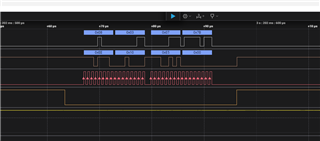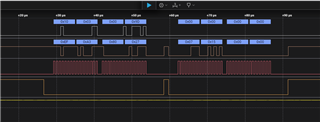Other Parts Discussed in Thread: ADS7038
Tool/software:
Team,
Could you please help with the below?
we have now decided to use the manual mode and to secure the data with a CRC at the SPI interface.
The settings used:
Manual mode: SEQUENCE_CFG_Register = 0x00
CRC enable: GENERAL_CFG_Register = 0x40
Enable append status: DATA_CFG_Register = 0x20
Oversampling: OSR_CFG_Register = 0x07
This works so far, we read 16 bit data and see 4-bit status and the CRC sum. CRC sum fits.
If we append the channel ID to the data instead of the status, we also see what is expected. The CRC is also correct then.
Now the questions:
1)Nowhere in the data sheet does it say which status bits are in which position in the 4 appended status bits.
I read 0x80 (which would already be 8 bits and not 4 and I cannot read from the read out from the data sheet at which bit position which status is).
-Could you clarify?
We work in manual mode with oversampling.
2)Where can I see whether the oversampling sequence has already been completed?
3)n this case, is oversampling also started with the rising edge of the CS or do I have to start the sequence separately (SEQ_START in SEQUENCE_CF_Register)?
Thanks in advance,
Anthony







